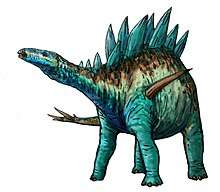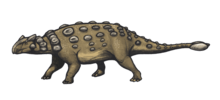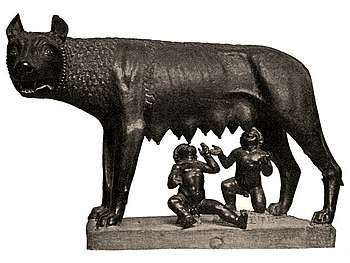Stegosaurus
Stegosaurus (/ˌstɛɡəˈsɔːrəs/[1]), from Greek stegos (στέγος) which means roof and sauros (σαῦρος) which means lizard, is a genus of herbivorous thyreophoran dinosaur. Fossils of this genus date to the Late Jurassic period, where they are found in Kimmeridgian to early Tithonian aged strata, between 155 and 150 million years ago, in the western United States and Portugal. Of the species that have been classified in the upper Morrison Formation of the western US, only three are universally recognized; S. stenops, S. ungulatus and S. sulcatus. The remains of over 80 individual animals of this genus have been found. Stegosaurus would have lived alongside dinosaurs such as Apatosaurus, Diplodocus, Brachiosaurus, Allosaurus, and Ceratosaurus; the latter two may have preyed on it.
| Stegosaurus | |
|---|---|
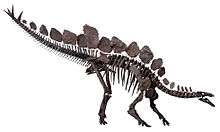 | |
| Mounted skeleton of S. stenops (nicknamed "Sophie"), Natural History Museum, London | |
| Scientific classification | |
| Kingdom: | Animalia |
| Phylum: | Chordata |
| Clade: | Dinosauria |
| Order: | †Ornithischia |
| Suborder: | †Stegosauria |
| Family: | †Stegosauridae |
| Subfamily: | †Stegosaurinae |
| Genus: | †Stegosaurus Marsh, 1877 |
| Type species | |
| †Stegosaurus stenops Marsh, 1887 | |
| Species | |
| |
| Synonyms | |
| |
These were large, heavily built, herbivorous quadrupeds with rounded backs, short fore limbs, long hind limbs, and tails held high in the air. Due to their distinctive combination of broad, upright plates and tail tipped with spikes, Stegosaurus is one of the most recognizable kinds of dinosaurs. The function of this array of plates and spikes has been the subject of much speculation among scientists. Today, it is generally agreed that their spiked tails were most likely used for defense against predators, while their plates may have been used primarily for display, and secondarily for thermoregulatory functions. Stegosaurus had a relatively low brain-to-body mass ratio. It had a short neck and a small head, meaning it most likely ate low-lying bushes and shrubs. One species, Stegosaurus ungulatus, is the largest known of all the stegosaurians (bigger than related dinosaurs such as Kentrosaurus and Huayangosaurus).
Stegosaurus remains were first identified during the "Bone Wars" by Othniel Charles Marsh at Dinosaur Ridge National Landmark. The first known skeletons were fragmentary and the bones were scattered, and it would be many years before the true appearance of these animals, including their posture and plate arrangement, became well understood. Despite its popularity in books and film, mounted skeletons of Stegosaurus did not become a staple of major natural history museums until the mid-20th century, and many museums have had to assemble composite displays from several different specimens due to a lack of complete skeletons. Stegosaurus is one of the better-known dinosaurs, and has been featured in film, postal stamps, and many other types of media.
Description

The quadrupedal Stegosaurus is one of the most easily identifiable dinosaur genera, due to the distinctive double row of kite-shaped plates rising vertically along the rounded back and the two pairs of long spikes extending horizontally near the end of the tail. Although large individuals could grow up to 9 m (29.5 ft) in length[2] and 5.3–7 metric tons (5.8–7.7 short tons) in weight,[3][4] the various species of Stegosaurus were dwarfed by contemporaries, the giant sauropods. Some form of armor appears to have been necessary, as Stegosaurus species coexisted with large predatory theropod dinosaurs, such as Allosaurus and Ceratosaurus.
Most of the information known about Stegosaurus comes from the remains of mature animals; more recently, though, juvenile remains of Stegosaurus have been found. One subadult specimen, discovered in 1994 in Wyoming, is 4.6 m (15.1 ft) long and 2 m (6.6 ft) high, and is estimated to have weighed 2.4 metric tons (2.6 short tons) while alive. It is on display in the University of Wyoming Geological Museum.[5]
Skull
The long and narrow skull was small in proportion to the body. It had a small antorbital fenestra, the hole between the nose and eye common to most archosaurs, including modern birds, though lost in extant crocodylians. The skull's low position suggests that Stegosaurus may have been a browser of low-growing vegetation. This interpretation is supported by the absence of front teeth and their likely replacement by a horny beak or rhamphotheca. The lower jaw had flat downward and upward extensions that would have completely hidden the teeth when viewed from the side, and these probably supported a turtle-like beak in life. The presence of a beak extended along much of the jaws may have precluded the presence of cheeks in these species.[6][7] Such an extensive beak was probably unique to Stegosaurus and some other advanced stegosaurids among ornithischians, which usually had beaks restricted to the jaw tips.[6][8] Other researchers have interpreted these ridges as modified versions of similar structures in other ornithischians which might have supported fleshy cheeks, rather than beaks.[9] Stegosaurian teeth were small, triangular, and flat; wear facets show that they did grind their food.[10]
Despite the animal's overall size, the braincase of Stegosaurus was small, being no larger than that of a dog. A well-preserved Stegosaurus braincase allowed Othniel Charles Marsh to obtain, in the 1880s, a cast of the brain cavity or endocast of the animal, which gave an indication of the brain size. The endocast showed the brain was indeed very small, the smallest proportionally of all dinosaur endocasts then known. The fact that an animal weighing over 4.5 metric tons (5 short tons) could have a brain of no more than 80 g (2.8 oz) contributed to the popular old idea that all dinosaurs were unintelligent, an idea now largely rejected.[11] Actual brain anatomy in Stegosaurus is poorly known, but the brain itself was small even for a dinosaur, fitting well with a slow, herbivorous lifestyle and limited behavioral complexity.[12]
Skeleton

In Stegosaurus stenops there are 27 bones in the vertebral column anterior to the sacrum, a varying number of vertebrae in the sacrum, with four in most subadults, and around 46 caudal (tail) vertebrae. The presacrals are divided into cervical (neck) and dorsal (back) vertebrae, with around 10 cervicals and 17 dorsals, the total number being one greater than in Hesperosaurus, two greater than Huayangosaurus, although Miragaia preserves 17 cervicals and an unknown number of dorsals. The first cervical vertebra is the axis bone, which is connected and often fused to the atlas bone. Farther posteriorly, the proportionately larger the cervicals become, although they do not change greatly in anything other than size. Past the first few dorsals, the centrum of the bones become more elongate front-to-back, and the transverse processes become more elevated dorsal. The sacrum of S. stenops includes four sacral vertebrae, but one of the dorsals is also incorporated into the structure. In some specimens of S. stenops, a caudal is also incorporated, as a caudosacral. In Hesperosaurus there are two dorsosacrals, and only four fused sacrals, but in Kentrosaurus there may be as many as seven vertebrae in the sacrum, with both dorsosacrals and caudosacrals. S. stenops preserves 46 caudal vertebrae, and up to 49, and along the series both the centrums and the neural spines become smaller, until the neural spines disappear at caudal 35. Around the middle of the tail, the neural spines become bifurcated, meaning they are divided near the top.[13]
With multiple well-preserved skeletons, S. stenops preserves all regions of the body, including the limbs. The scapula (shoulder blade) is sub-rectangular, with a robust blade. Though it is not always perfectly preserved, the acromion ridge is slightly larger than in Kentrosaurus. The blade is relatively straight, although it curves towards the back. There is a small bump on the back of the blade, that would have served as the base of the triceps muscle. Articulated with the scapula, the coracoid is sub-circular.[13] The hind feet each had three short toes, while each fore foot had five toes; only the inner two toes had a blunt hoof. The phalangeal formula is 2-2-2-2-1, meaning the innermost finger of the fore limb has two bones, the next has two, etc.[14] All four limbs were supported by pads behind the toes.[15] The fore limbs were much shorter than the stocky hind limbs, which resulted in an unusual posture. The tail appears to have been held well clear of the ground, while the head of Stegosaurus was positioned relatively low down, probably no higher than 1 m (3.3 ft) above the ground.[16]
Plates

The most recognizable features of Stegosaurus are its dermal plates, which consisted of between 17 and 22 separate plates and flat spines.[17] These were highly modified osteoderms (bony-cored scales), similar to those seen in crocodiles and many lizards today. They were not directly attached to the animal's skeleton, instead arising from the skin. The largest plates were found over the hips and could measure over 60 cm (24 in) wide and 60 cm (24 in) tall.[17]
In a 2010 review of Stegosaurus species, Peter Galton suggested that the arrangement of the plates on the back may have varied between species, and that the pattern of plates as viewed in profile may have been important for species recognition. Galton noted that the plates in S. stenops have been found articulated in two staggered rows, rather than paired. Fewer S. ungulatus plates have been found, and none articulated, making the arrangement in this species more difficult to determine. However, the type specimen of S. ungulatus preserves two flattened spine-like plates from the tail that are nearly identical in shape and size, but are mirror images of each other, suggesting that at least these were arranged in pairs.[18] Many of the plates are manifestly chiral[19][20] and no two plates of the same size and shape have been found for an individual; however plates have been correlated between individuals. Well preserved integumentary impressions of the plates of Hesperosaurus show a smooth surface with long and parallel, shallow grooves. This indicates that the plates were covered in keratinous sheaths.[21]
Discovery and history
Stegosaurus, one of the many dinosaurs first collected and described in the Bone Wars, was originally named by Othniel Charles Marsh in 1877,[22] from remains recovered north of Morrison, Colorado. These first bones became the holotype of Stegosaurus armatus. Marsh initially believed the remains were from an aquatic turtle-like animal, and the basis for its scientific name, 'roof(ed) lizard' was due to his early belief that the plates lay flat over the animal's back, overlapping like the shingles (tiles) on a roof. A wealth of Stegosaurus material was recovered over the next few years, and Marsh published several papers on the genus from 1877 to 1897.[23] In 1878, Edward Drinker Cope named Hypsirhophus discurus, as another stegosaurian based on fragmentary fossils specimens from Cope's Quarry 3 near the "Cope's Nipple" site in Garden Park, Colorado.[24] Many later researchers have considered Hypsirhophus to be a synonym of Stegosaurus,[23] though Peter Galton (2010) suggested that it is distinct based on differences in the vertebrae.[18]
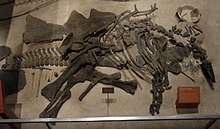
Marsh named a second species, Stegosaurus ungulatus, in 1879, and finally gave a more detailed description of all the Stegosaurus fossils collected to far the following year.[18] In 1881, he named a third species Stegosaurus "affinis", based only on a hip bone. This species is generally agreed to have been inadequately described, and therefore is a nomen nudum (a name lacking a formal description). The specimen was later lost.[18] Marsh continued to collect and examine new Stegosaurus specimens, and in 1887 he named three new species: Stegosaurus stenops, S. duplex, and S. sulcatus.[23] Though it had not yet been completely prepared, the nearly complete and articulated type specimen of Stegosaurus stenops allowed Marsh to complete the first attempt at a reconstructed Stegosaurus skeleton. This first reconstruction, of S. ungulatus with missing parts filled in from S. stenops, was published by Marsh in 1891. (In 1893, Richard Lydekker mistakenly re-published Marsh's drawing under the label Hypsirhophus).[23]

The next species of Stegosaurus to be named was S. marshi, by Frederick Lucas in 1901. Lucas reclassified this species in the new genus Hoplitosaurus later that year. Lucas also re-examined the issue of the life appearance of Stegosaurus, coming to the conclusion that the plates were arranged in pairs in two rows along the back, arranged above the bases of the ribs. Lucas commissioned Charles R. Knight to produce a life restoration of S. ungulatus based on his new interpretation. However, the following year, Lucas wrote that he now believed the plates were probably attached in staggered rows.[23] In 1910, Richard Swann Lull wrote that the alternating pattern seen in S. stenops was probably due to shifting of the skeleton after death. He led the construction of the first ever Stegosaurus skeletal mount at the Peabody Museum of Natural History, which was depicted with paired plates.[23] In 1914, Charles Gilmore argued against Lull's interpretation, noting that several specimens of S. stenops, including the now-completely prepared holotype, preserved the plates in alternating rows near the peak of the back, and that there was no evidence of the plates having shifted relative to the body during fossilization.[23] Gilmore and Lucas' interpretation became the generally accepted standard, and Lull's mount at the Peabody Museum was changed to reflect this in 1924.[17]
Sophie the Stegosaurus is the most nearly complete fossil specimen of a Stegosaurus.[25] It is a young adult of undetermined sex, 5.6 metres (18 ft) long and 2.9 metres (9.5 ft) tall. The specimen, which was found in Wyoming, is 85% intact, containing 360 bones. It was put on display at the Natural History Museum, London in December 2014.[26][27]
Plate arrangement
One of the major subjects of books and articles about Stegosaurus is the plate arrangement.[28] The argument has been a major one in the history of dinosaur reconstruction. Four possible plate arrangements have been proposed over the years:
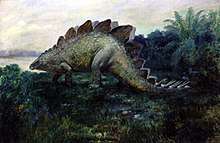
- The plates lie flat along the back, as a shingle-like armor. This was Marsh's initial interpretation, which led to the name 'roof lizard'. As further and complete plates were found, their form showed they stood on edge, rather than lying flat.
- By 1891, Marsh published a more familiar view of Stegosaurus,[29] with a single row of plates. This was dropped fairly early on (apparently because it was poorly understood how the plates were embedded in the skin and they were thought to overlap too much in this arrangement). It was revived, in somewhat modified form, in the 1980s, by Stephen Czerkas,[30] based on the arrangement of iguana dorsal spines.
- The plates were paired in a double row along the back, such as in Knight's 1901 reconstruction and the 1933 film King Kong.
- Two rows of alternating plates. By the early 1960s, this had become (and remains) the prevalent idea, mainly because some S. stenops fossils in which the plates are still partially articulated show this arrangement. This arrangement is chiral and so demands that a specimen be distinguished from its distinct, hypothetical mirror-image form.[19][20]
Species
Many of the species initially described have since been considered to be invalid or synonymous with earlier named species,[31] leaving two well-known and one poorly known species. Confirmed Stegosaurus remains have been found in the Morrison Formation's stratigraphic zones 2–6, with additional remains possibly referrable to Stegosaurus recovered from stratigraphic zone 1.[32]
- Stegosaurus ungulatus, meaning "hoofed roof lizard", was named by Marsh in 1879,[33] from remains recovered at Como Bluff, Wyoming (Quarry 12, near Robber's Roost).[31] It might be synonymous with S. stenops.[13] At 9 m (29.5 ft), it was the longest species within the genus Stegosaurus. A fragmentary Stegosaurus specimen discovered in Portugal and dating from the upper Kimmeridgian-lower Tithonian stage has been tentatively assigned to this species.[34] Stegosaurus ungulatus can be distinguished from S. stenops by the presence of longer hind limbs, proportionately smaller, more pointed plates with wide bases and narrow tips, and by several small, flat, spine-like plates just before the spikes on the tail. These spine-like plates appear to have been paired, due to the presence of at least one pair that are identical but mirrored. S. ungulatus also appears to have had longer legs (femora) and hip bones than other species. The type specimen of S. ungulatus was discovered with eight spikes, though they were scattered away from their original positions. These have often been interpreted as indicating that the animal had four pairs of tail spikes. No specimens have been found with complete or articulated sets of tail spikes, but no additional specimens have been found that preserve eight spikes together. It is possible the extra pair of spikes came from a different individual, and though no other extra bones were found with the specimen, these may be found if more digging were done at the original site.[18] Specimens from other quarries (such as a tail from Quarry 13, now forming part of the composite skeleton AMNH 650 at the American Museum of Natural History), referred to S. ungulatus on the basis of their notched tail vertebrae, are preserved with only four tail spikes.[31] The type specimen of S. ungulatus (YPM 1853) was incorporated into the first ever mounted skeleton of a stegosaur at the Peabody Museum of Natural History in 1910 by Richard Swann Lull. It was initially mounted with paired plates set wide, above the base of the ribs, but was remounted in 1924 with two staggered rows of plates along the midline of the back.[17] Additional specimens recovered from the same quarry by the United States National Museum of Natural History, including tail vertebrae and an additional large plate (USNM 7414), belong to the same individual as YPM 1853.[18]
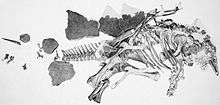
- Stegosaurus stenops, meaning "narrow-faced roof lizard", was named by Marsh in 1887,[35] with the holotype having been collected by Marshall Felch at Garden Park, north of Cañon City, Colorado, in 1886. This is the best-known species of Stegosaurus, mainly because its remains include at least one complete articulated skeleton. It had proportionately large, broad plates and rounded tail plates. Articulated specimens show that the plates were arranged alternating in a staggered double row. S. stenops is known from at least 50 partial skeletons of adults and juveniles, one complete skull, and four partial skulls. It was shorter than other species, at 7 m (23 ft). Found in the Morrison Formation, Colorado, Wyoming, and Utah.[9]
- Stegosaurus sulcatus, meaning "furrowed roof lizard", was described by Marsh in 1887 based on a partial skeleton.[35] It has traditionally been considered a synonym of S. armatus,[9] though more recent studies suggest it is not.[18] S. sulcatus is distinguished mainly by its unusually large, furrowed spikes with very large bases. A spike associated with the type specimen, originally thought to be a tail spike, may in fact come from the shoulder or hip, since its base is much larger than the corresponding tail vertebrae. A review published by Maidment and colleagues in 2008 regarded it as an indeterminate species possibly not even belonging to Stegosaurus at all, but to a different genus.[36][37] Peter Galton suggested it should be considered a valid species due to its unique spikes.[18]
Susannah Maidment and colleagues in 2008 proposed extensive alterations to the taxonomy of Stegosaurus. They advocated synonymizing S. stenops and S. ungulatus with S. armatus, and sinking Hesperosaurus and Wuerhosaurus into Stegosaurus, with their type species becoming Stegosaurus mjosi and Stegosaurus homheni, respectively. They regarded S. longispinus as dubious. Thus, their conception of Stegosaurus would include three valid species (S. armatus, S. homheni, and S. mjosi) and would range from the Late Jurassic of North America and Europe to the Early Cretaceous of Asia.[36] However, this classification scheme was not followed by other researchers, and a 2017 cladistic analysis co-authored by Maidment with Thomas Raven rejects the synonymy of Hesperosaurus with Stegosaurus.[18][38] In 2015, Maidment et al. revised their suggestion due to the recognition by Galton of S. armatus as a nomen dubium and its replacement by S. stenops as type species.[13]
Doubtful species and junior synonyms
- Stegosaurus armatus, meaning "armored roof lizard", was the first species to be found and the original type species named by O.C. Marsh in 1877.[22] It is known from a partial skeletons, and more than 30 fragmentary specimens have been referred to it.[9] However, the type specimen was very fragmentary, consisting only of a partial tail, hips, and leg, parts of some back vertebrae, and a single fragmentary plate (the presence of which was used to give the animal its name). No other plates or spikes were found, and the entire front half of the animal appears not to have been preserved.[31] Because the type specimen is very fragmentary, it is extremely difficult to compare it with other species based on better specimens, and it is now generally considered to be a nomen dubium. Because of this, it was replaced by S. stenops as the type species of Stegosaurus in a ruling of the ICZN in 2013.[39]
- Stegosaurus "affinis", named by Marsh in 1881, is only known from a pubis which has since been lost. Because Marsh did not provide an adequate description of the bone with which to distinguish a new species, this name is considered a nomen nudum.[23]
- Diracodon laticeps was described by Marsh in 1881, from some jawbone fragments.[40] Bakker resurrected D. laticeps in 1986 as a senior synonym of S. stenops,[41] although others note that the material is not diagnostic and is only referable to Stegosaurus sp., making it a nomen dubium.[31]
- Stegosaurus duplex, meaning "two plexus roof lizard" (in allusion to the greatly enlarged neural canal of the sacrum which Marsh characterized as a "posterior brain case"), was named by Marsh in 1887 (including the holotype specimen). The disarticulated bones were actually collected in 1879 by Edward Ashley at Como Bluff. Marsh initially distinguished it from S. ungulatus based on the fact that each sacral (hip) vertebra bore its own rib, which he claimed was unlike the anatomy of S. ungulatus; however, the sacrum of S. ungulatus had not actually been discovered. Marsh also suggested that S. duplex may have lacked armor, since no plates or spikes were found with the specimen, though a single spike may actually have been present nearby, and re-examination of the site maps has shown that the entire specimen was found highly disarticulated and scattered.[31] It is generally considered a synonym of S. ungulatus today, and parts of the specimen were actually incorporated into the Peabody Museum S. ungulatus skeletal mount in 1910.[18]
Reassigned species
- Stegosaurus marshi, which was described by Lucas in 1901, was renamed Hoplitosaurus in 1902.[42]
- Stegosaurus priscus, described by Nopcsa in 1911, was reassigned to Lexovisaurus,[9] and is now the type species of Loricatosaurus.[36]
- Stegosaurus longispinus was named by Charles W. Gilmore.[23] It is now the type species of the genus Alcovasaurus.[43]
- Stegosaurus madagascariensis from Madagascar is known solely from teeth and was described by Piveteau in 1926. The teeth were variously attributed to a stegosaur, the theropod Majungasaurus,[44] a hadrosaur or even a crocodylian, but is now considered a possible ankylosaur.[36]
Classification

Stegosaurus was the first-named genus of the family Stegosauridae. It is the type genus that gives its name to the family. The Stegosauridae are one of two families within the infraorder Stegosauria, with the other being the Huayangosauridae. The infraorder Stegosauria lies within the Thyreophora, or armored dinosaurs, a suborder which also includes the more diverse ankylosaurs. The stegosaurs were a clade of animals similar in appearance, posture, and shape that mainly differed in their array of spikes and plates. Among the closest relatives to Stegosaurus are Wuerhosaurus from China and Kentrosaurus from East Africa.
The following cladogram shows the position of Stegosaurus within the Stegosauridae according to Mateus, 2009:[45]
| Stegosauridae |
| ||||||||||||||||||||||||||||||||||||
Origin
The origin of Stegosaurus is uncertain, as few remains of basal stegosaurs and their ancestors are known. Recently, stegosaurids have been shown to be present in the lower Morrison Formation, existing several million years before the occurrence of Stegosaurus itself, with the discovery of the related Hesperosaurus from the early Kimmeridgian.[46] The earliest stegosaurid (the genus Lexovisaurus) is known from the Oxford Clay Formation of England and France, giving it an age of early to middle Callovian.
The earlier and more basal genus Huayangosaurus from the Middle Jurassic of China (some 165 million years ago – Mya) antedates Stegosaurus by 20 million years and is the only genus in the family Huayangosauridae. Earlier still is Scelidosaurus, from Early Jurassic England, which lived about 190 Mya. It possessed features of both stegosaurs and ankylosaurs. Emausaurus from Germany was another small quadruped, while Scutellosaurus from Arizona was an even earlier genus and was facultatively bipedal. These small, lightly armored dinosaurs were closely related to the direct ancestor of both stegosaurs and ankylosaurs. A trackway of a possible early armored dinosaur, from around 195 Mya, has been found in France.[47]
Paleobiology
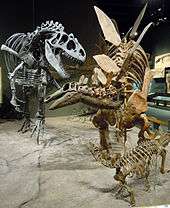
Soon after its discovery, Marsh considered Stegosaurus to have been bipedal, due to its short forelimbs.[48] He had changed his mind, however, by 1891, after considering the heavy build of the animal.[29] Although Stegosaurus is undoubtedly now considered to have been quadrupedal, some discussion has occurred over whether it could have reared up on its hind legs, using its tail to form a tripod with its hind limbs, to browse for higher foliage.[9] This has been proposed by Bakker[41][49] and opposed by Carpenter.[16] A study by Mallison (2010) found support a rearing up posture in Kentrosaurus, though not for ability for the tail to act as a tripod.[50]
Stegosaurus had short fore limbs in relation to its hind limb. Furthermore, within the hind limbs, the lower section (comprising the tibia and fibula) was short compared with the femur. This suggests it could not walk very fast, as the stride of the back legs at speed would have overtaken the front legs, giving a maximum speed of 6–7 km/h (3.7–4.3 mph).[10] Tracks discovered by Matthew Mossbrucker (Morrison Natural History Museum, Colorado) suggest that Stegosaurus lived in multiple-age herds. One group of tracks is interpreted as showing four or five baby stegosaurs moving in the same direction, while another has a juvenile stegosaur track with an adult track overprinting it.[51]
As the plates would have been obstacles during copulation, it is possible the female stegosaur laid on her side as the male mounted her from behind. Another suggestion is that the female would stand on all fours but squat the fore limbs and raise the tail slightly to the side as the male rested this fore limbs on her broad pelvis. However, this would not explain how their reproductive organs can touch as there is no evidence of muscle attachments for a mobile penis nor a baculum in dinosaurs.[52]
Plate function
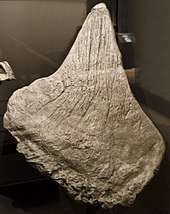
The function of Stegosaurus' plates has been much debated. Marsh suggested that they functioned as some form of armor,[48] though Davitashvili (1961) disputed this, claiming that they were too fragile and ill-placed for defensive purposes, leaving the animal's sides unprotected.[53] Nevertheless, others have continued to support a defensive function. Bakker suggested in 1986 that the plates were covered in horn comparing the surface of the fossilized plates to the bony cores of horns in other animals known or thought to bear horns.[54] Christiansen and Tschopp (2010), having studied a well-preserved specimen of Hesperosaurus with skin impressions, concluded that the plates were covered in a keratin sheath which would have strengthened the plate as a whole and provided it with sharp cutting edges.[21] Bakker stated that Stegosaurus could flip its osteoderms from one side to another to present a predator with an array of spikes and blades that would impede it from closing sufficiently to attack the Stegosaurus effectively. He contends that they had insufficient width for them to stand erect easily in such a manner as to be useful in display without continuous muscular effort.[54] Mobility of the plates, however, has been disputed by other paleontologists.[55]
Another possible function of the plates is they may have helped to control the body temperature of the animal,[55] in a similar way to the sails of the pelycosaurs Dimetrodon and Edaphosaurus (and modern elephant and rabbit ears). The plates had blood vessels running through grooves and air flowing around the plates would have cooled the blood.[56] Buffrénil, et al. (1986) found "extreme vascularization of the outer layer of bone",[57][55] which was seen has evidence that the plates "acted as thermoregulatory devices".[57] Likewise, 2010 structural comparisons of Stegosaurus plates to Alligator osteoderms seem to support the conclusion that the potential for a thermoregulatory role in the plates of Stegosaurus definitely exists.[58]

The thermoregulation hypothesis has been seriously questioned, since other stegosaurs such as Kentrosaurus, had more low surface area spikes than plates, implying that cooling was not important enough to require specialized structural formations such as plates. However, it has also been suggested that the plates could have helped the animal increase heat absorption from the sun. Since a cooling trend occurred towards the end of the Jurassic, a large ectothermic reptile might have used the increased surface area afforded by the plates to absorb radiation from the sun.[59] Christiansen and Tschopp (2010) state that the presence of a smooth, insulating keratin covering would have hampered thermoregulation, but such a function cannot be entirely ruled out as extant cattle and ducks use horns and beaks to dump excess heat despite the keratin covering.[21] Histological surveys of plate microstructure attributed the vascularization to the need to transport nutrients for rapid plate growth.[57][60] The vascular system of the plates have been theorized to have played a role in threat displaying as Stegosaurus could have pumped blood into them, causing them to "blush" and give a colorful, red warning.[61] However, Christiansen and Tschopp (2010) consider this unlikely, as stegosaur plates were covered in horn rather than skin.[21]
The plates' large size suggests that they may have served to increase the apparent height of the animal, either to intimidate enemies[23] or to impress other members of the same species in some form of sexual display.[53] A 2015 study of the shapes and sizes of Hesperosaurus plates suggested that they were sexually dimorphic, with wide plates belonging to males and taller plates belonging to females.[62] Christiansen and Tschopp (2010) proposed that the display function would have been reinforced by the horny sheath which would have increased the visible surface and such horn structures are often brightly colored.[21] Some have suggested that plates in stegosaurs were used to allow individuals to identify members of their species.[60] The use of exaggerated structures in dinosaurs as species identification has been questioned, as no such function exists in modern species.[63]
Thagomizer (tail spikes)
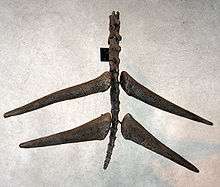
Debate has been going on about whether the tail spikes were used for display only, as posited by Gilmore in 1914[23] or used as a weapon. Robert Bakker noted the tail was likely to have been much more flexible than that of other dinosaurs, as it lacked ossified tendons, thus lending credence to the idea of the tail as a weapon. However, as Carpenter[16] has noted, the plates overlap so many tail vertebrae, movement would be limited. Bakker also observed that Stegosaurus could have maneuvered its rear easily, by keeping its large hind limbs stationary and pushing off with its very powerfully muscled but short forelimbs, allowing it to swivel deftly to deal with attack.[41] More recently, a study of the tail spikes by McWhinney et al.,[64] which showed a high incidence of trauma-related damage, lends more weight to the position that the spikes were indeed used in combat. This study showed that 9.8% of Stegosaurus specimens examined had injuries to their tail spikes. Additional support for this idea was a punctured tail vertebra of an Allosaurus into which a tail spike fits perfectly.[65]
S. stenops had four dermal spikes, each about 60–90 cm (2.0–3.0 ft) long. Discoveries of articulated stegosaur armor show, at least in some species, these spikes protruded horizontally from the tail, not vertically as is often depicted.[16] Initially, Marsh described S. ungulatus as having eight spikes in its tail, unlike S. stenops. However, recent research re-examined this and concluded this species also had four.[31]
"Second brain"

At one time, stegosaurs were described as having a "second brain" in their hips. Soon after describing Stegosaurus, Marsh noted a large canal in the hip region of the spinal cord, which could have accommodated a structure up to 20 times larger than the famously small brain. This has led to the influential idea that dinosaurs like Stegosaurus had a "second brain" in the tail, which may have been responsible for controlling reflexes in the rear portion of the body. This "brain" was proposed to have given a Stegosaurus a temporary boost when it was under threat from predators.[10]
This space, however, is more likely to have served other purposes. The sacro-lumbar expansion is not unique to stegosaurs, nor even sauropods. It is also present in birds. In their case, it contains what is called the glycogen body, a structure whose function is not definitely known, but which is postulated to facilitate the supply of glycogen to the animal's nervous system.[66] It also may function as a balance organ, or reservoir of compounds to support the nervous system.[67]
Growth
Juveniles of Stegosaurus have been preserved, probably showing the growth of the genus. The two juveniles are both relatively small, with the smaller individual being 1.5 m (4.9 ft) long, and the larger having a length of 2.6 m (8.5 ft). The specimens can be identified as not mature because they lack the fusion of the scapula and coracoid, and the lower hind limbs. Also, the pelvic region of the specimens are similar to Kentrosaurus juveniles.[68] One 2009 study of Stegosaurus specimens of various sizes found that the plates and spikes had delayed histological growth in comparison to the skeleton and when the dinosaur reached maturity, growth in the osteoderms may have greatly outpaced that of the skeleton.[69] A 2013 study concluded, based on the rapid deposition of highly vascularised fibrolamellar bone, that Kentrosaurus had a quicker growth rate than Stegosaurus, contradicting the general rule that larger dinosaurs grew faster than smaller ones.[70]
Diet
Stegosaurus and related genera were herbivores. However, their teeth and jaws are very different from those of other herbivorous ornithischian dinosaurs, suggesting a different feeding strategy that is not yet well understood. The other ornithischians possessed teeth capable of grinding plant material and a jaw structure capable of movements in planes other than simply orthal (i.e. not only the fused up-down motion to which stegosaur jaws were likely limited). Unlike the sturdy jaws and grinding teeth common to its fellow ornithischians, Stegosaurus (and all stegosaurians) had small, peg-shaped teeth that have been observed with horizontal wear facets associated with tooth-food contact[71] and their unusual jaws were probably capable of only orthal (up-down) movements.[9] Their teeth were "not tightly pressed together in a block for efficient grinding",[72] and no evidence in the fossil record of stegosaurians indicates use of gastroliths—the stone(s) some dinosaurs (and some present-day bird species) ingested—to aid the grinding process, so how exactly Stegosaurus obtained and processed the amount of plant material required to sustain its size remains "poorly understood".[72]

The stegosaurians were widely distributed geographically in the late Jurassic.[9] Palaeontologists believe it would have eaten plants such as mosses, ferns, horsetails, cycads, and conifers or fruits.[73] Grazing on grasses, seen in many modern mammalian herbivores, would not have been possible for Stegosaurus, as grasses did not evolve until late into the Cretaceous Period, long after Stegosaurus had become extinct.
One hypothesized feeding behavior strategy considers them to be low-level browsers, eating low-growing fruit of various nonflowering plants, as well as foliage. This scenario has Stegosaurus foraging at most 1 m above the ground.[74] Conversely, if Stegosaurus could have raised itself on two legs, as suggested by Bakker, then it could have browsed on vegetation and fruits quite high up, with adults being able to forage up to 6 m (20 ft) above the ground.[10]
A detailed computer analysis of the biomechanics of Stegosaurus's feeding behavior was performed in 2010, using two different three-dimensional models of Stegosaurus teeth given realistic physics and properties. Bite force was also calculated using these models and the known skull proportions of the animal, as well as simulated tree branches of different size and hardness. The resultant bite forces calculated for Stegosaurus were 140.1 newtons (N), 183.7 N, and 275 N (for anterior, middle and posterior teeth, respectively), which means its bite force was less than half that of a Labrador retriever. Stegosaurus could have easily bitten through smaller green branches, but would have had difficulty with anything over 12 mm in diameter. Stegosaurus, therefore, probably browsed primarily among smaller twigs and foliage, and would have been unable to handle larger plant parts unless the animal was capable of biting much more efficiently than predicted in this study.[75] However, a study published on May 20, 2016 by Stephen Lautenschlager et al. indicates Stegosaurus's bite strength was stronger than previously believed. Comparisons were made between it (represented by a specimen known as "Sophie" from the United Kingdom's Natural History Museum) and two other herbivorous dinosaurs; Erlikosaurus and Plateosaurus to determine if all three had similar bite forces and similar niches. Based on the results of the study, it was revealed that Stegosaurus had a bite similar in strength to that of modern herbivorous mammals, in particular, cattle and sheep. Based on this data, it is likely Stegosaurus also ate woodier, tougher plants such as cycads, perhaps even acting as a means of spreading cycad seeds. The findings were published in the journal Scientific Reports.[76]
Paleoecology
_(15354473407).jpg)
The Morrison Formation is interpreted as a semiarid environment with distinct wet and dry seasons, and flat floodplains. Vegetation varied from river-lining forests of conifers, tree ferns, and ferns (gallery forests), to fern savannas with occasional trees such as the Araucaria-like conifer Brachyphyllum. The flora of the period has been revealed by fossils of green algae, fungi, mosses, horsetails, ferns, cycads, ginkoes, and several families of conifers. Animal fossils discovered include bivalves, snails, ray-finned fishes, frogs, salamanders, turtles like Dorsetochelys, sphenodonts, lizards, terrestrial and aquatic crocodylomorphans like Hoplosuchus, several species of pterosaurs such as Harpactognathus and Mesadactylus, numerous dinosaur species, and early mammals such as docodonts (like Docodon), multituberculates, symmetrodonts, and triconodonts.[77]
Dinosaurs that lived alongside Stegosaurus included theropods Allosaurus, Saurophaganax, Torvosaurus, Ceratosaurus, Marshosaurus, Stokesosaurus, Ornitholestes, Coelurus and Tanycolagreus. Sauropods dominated the region, and included Brachiosaurus, Apatosaurus, Diplodocus, Camarasaurus, and Barosaurus. Other ornithischians included Camptosaurus, Gargoyleosaurus, Dryosaurus, Othnielosaurus and Drinker.[78] Stegosaurus is commonly found at the same sites as Allosaurus, Apatosaurus, Camarasaurus, and Diplodocus. Stegosaurus may have preferred drier settings than these other dinosaurs.[79]
In popular culture
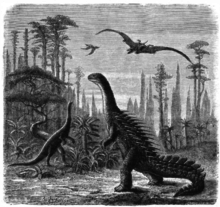
One of the most recognizable of all dinosaurs,[10] Stegosaurus has been depicted on film, in cartoons and comics and as children's toys. Due to the fragmentary nature of most early Stegosaurus fossil finds, it took many years before reasonably accurate restorations of this dinosaur could be produced. The earliest popular image of Stegosaurus was an engraving produced by A. Tobin for the November 1884 issue of Scientific American, which included the dinosaur amid a speculative Morrison age landscape. Tobin restored the Stegosaurus as bipedal and long-necked, with the plates arranged along the tail and the back covered in spikes. This covering of spikes might have been based on a misinterpretation of the teeth, which Marsh had noted were oddly shaped, cylindrical, and found scattered, such that he thought they might turn out to be small dermal spines.[80]
Marsh published his more accurate skeletal reconstruction of Stegosaurus in 1891, and within a decade Stegosaurus had become among the most-illustrated types of dinosaur.[80] Artist Charles R. Knight published his first illustration of Stegosaurus ungulatus based on Marsh's skeletal reconstruction in a November 1897 issue of The Century Magazine. This illustration would later go on to form the basis of the stop-motion puppet used in the 1933 film King Kong.[81] Like Marsh's reconstruction, Knight's first restoration had a single row of large plates, though he next used a double row for his more well-known 1901 painting, produced under the direction of Frederic Lucas. Again under Lucas, Knight revised his version of Stegosaurus again two years later, producing a model with a staggered double row of plates. Knight would go on to paint a stegosaur with a staggered double plate row in 1927 for the Field Museum of Natural History, and was followed by Rudolph F. Zallinger, who painted Stegosaurus this way in his "Age of Reptiles" mural at the Peabody Museum in 1947.[81]
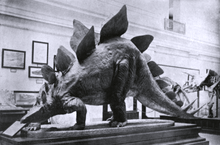
Stegosaurus made its major public debut as a paper mache model commissioned by the U.S. National Museum of Natural History for the 1904 Louisiana Purchase Exposition. The model was based on Knight's latest miniature with the double row of staggered plates,[82] and was exhibited in the United States Government Building at the exposition in St. Louis before being relocated to Portland, Oregon for the Lewis and Clark Centennial Exposition in 1905. The model was moved to the Smithsonian National Museum of Natural History (now the Arts and Industries Building) in Washington, D.C. along with other prehistory displays, and to the current National Museum of Natural History building in 1911. Following renovations to the museum in the 2010s, the model was moved once again for display at the Museum of the Earth in Ithaca, New York.[83]
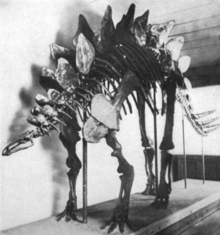
The popularity of Stegosaurus is owed partly to its prominent display in natural history museums. Though considered one of the most distinctive types of dinosaur, Stegosaurus displays were missing from a majority of museums during the first half of the 20th century, due largely to the disarticulated nature of most fossil specimens.[82] Until 1918, the only mounted skeleton of Stegosaurus in the world was O. C. Marsh's type specimen of S. ungulatus at the Peabody Museum of Natural History, which was put on display in 1910. However, this mount was dismantled in 1917 when the old Peabody Museum building was demolished.[82] This historically significant specimen was re-mounted ahead of the opening of the new Peabody Museum building in 1925.[17] 1918 saw the completion of the second Stegosaurus mount, and the first depicting S. stenops. This mount was created under the direction of Charles Gilmore at the U.S. National Museum of Natural History. It was a composite of several skeletons, primarily USNM 6531, with proportions designed to closely follow the S. stenops type specimen, which had been on display in relief nearby since 1918.[82] The aging mount was dismantled in 2003 and replaced with a cast in an updated pose in 2004.[84] A third mounted skeleton of Stegosaurus, referred to S. stenops, was put on display at the American Museum of Natural History in 1932. Mounted under the direction of Charles J. Long, the American Museum mount was a composite consisting of partial remains filled in with replicas based on other specimens. In his article about the new mount for the museum's journal, Barnum Brown described (and disputed) the popular misconception that the Stegosaurus had a "second brain" in its hips.[85] Another composite mount, using specimens referred to S. ungulatus collected from Dinosaur National Monument between 1920 and 1922, was put on display at the Carnegie Museum of Natural History in 1940.[86]
See also
- Timeline of stegosaur research
References
- "Stegosaurus". Merriam-Webster Dictionary.
- Holtz, Thomas R. Jr. (2012) Dinosaurs: The Most Complete, Up-to-Date Encyclopedia for Dinosaur Lovers of All Ages, Winter 2011 Appendix.
- Foster, J.R. (2003). Paleoecological analysis of the vertebrate fauna of the Morrison Formation (Upper Jurassic), Rocky Mountain region, U.S.A. New Mexico Museum of Natural History and Science Bulletin, 23. Albuquerque, New Mexico: New Mexico Museum of Natural History and Science.
- Benson, RBJ; Campione, NE; Carrano, MT; Mannion, PD; Sullivan, C; Evans, David C.; et al. (2014). "Rates of Dinosaur Body Mass Evolution Indicate 170 Million Years of Sustained Ecological Innovation on the Avian Stem Lineage". PLoS Biol. 12 (5): e1001853. doi:10.1371/journal.pbio.1001853. PMC 4011683. PMID 24802911.
- Stegosaurus. University of Wyoming Geological Museum. 2006. Retrieved October 6, 2006. University of Wyoming Geological Museum Archived 2006-08-27 at the Wayback Machine
- Knoll, F (2008). "Buccal soft anatomy in Lesothosaurus (Dinosauria: Ornithischia)" (PDF). Neues Jahrbuch für Geologie und Paläontologie, Abhandlungen. 248 (3): 355–364. doi:10.1127/0077-7749/2008/0248-0355.
- Czerkas, S (1999). "The beaked jaws of stegosaurs and their implications for other ornithischians". Miscellaneous Publication of the Utah Geological Survey. 99–1: 143–150.
- Barrett, P.M. (2001). Tooth wear and possible jaw action of Scelidosaurus harrisonii Owen and a review of feeding mechanisms in other thyreophoran dinosaurs. Pp. 25-52 in Carpenter, K. (ed.): The Armored Dinosaurs. Bloomington: Indiana University Press.
- Galton PM, Upchurch P (2004). "Stegosauria". In Weishampel DB, Dodson P, Osmólska H (eds.). The Dinosauria (2nd ed.). University of California Press. ISBN 978-0-520-24209-8.
- Fastovsky DE, Weishampel DB (2005). "Stegosauria: Hot Plates". In Fastovsky DE, Weishampel DB (eds.). The Evolution and Extinction of the Dinosaurs (2nd ed.). Cambridge University Press. pp. 107–30. ISBN 978-0-521-81172-9.
- Bakker RT (1986). The Dinosaur Heresies. William Morrow, New York. pp. 365–74.
- Buchholtz, Emily; Holtz, Thomas R., Jr.; Farlow, James O.; Walters, Bob (2012-06-27). Brett-Surman, M.K. (ed.). The complete dinosaur (2nd ed.). Bloomington, Ind.: Indiana University Press. p. 201. ISBN 978-0-253-00849-7. Retrieved 27 February 2013.
Proportions and anatomy of endocasts of Stegosaurus vary little from those of ancestral archosaurs, with an elongated shape, large olfractory lobes, and extremely narrow cerebral hemispheres. Lack of surface detail suggest that the brain did not fill the braincase. EQ estimates are below 0,6 (Hoppson, 1977), agreeing well with predictions of a slow herbivorous lifestyle.
- Maidment, S. C. R.; Brassey, Charlotte; Barrett, Paul Michael (2015). "The Postcranial Skeleton of an Exceptionally Complete Individual of the Plated Dinosaur Stegosaurus stenops (Dinosauria: Thyreophora) from the Upper Jurassic Morrison Formation of Wyoming, U.S.A." PLoS ONE. 10 (10): e0138352. Bibcode:2015PLoSO..1038352M. doi:10.1371/journal.pone.0138352. PMC 4605687. PMID 26466098.
- Martin, A.J. (2006). Introduction to the Study of Dinosaurs. Second Edition. Oxford, Blackwell Publishing. 560 pp. ISBN 1-4051-3413-5.
- Lambert D (1993). The Ultimate Dinosaur Book. Dorling Kindersley, New York. pp. 110–29. ISBN 978-1-56458-304-8.
- Carpenter K (1998). "Armor of Stegosaurus stenops, and the taphonomic history of a new specimen from Garden Park Colorado". The Upper Jurassic Morrison Formation: An Interdisciplinary Study. Part 1. Modern Geol. 22. pp. 127–44.
- Revan, A. (2011). Reconstructing an Icon: Historical Significance of the Peabody’s Mounted Skeleton of Stegosaurus and the Changes Necessary to Make It Correct Anatomically. Doctoral dissertation, faculty of the Department of Geology and Geophysics, Yale University.
- Galton, P.M. (2010). "Species of plated dinosaur Stegosaurus (Morrison Formation, Late Jurassic) of western USA: new type species designation needed". Swiss Journal of Geosciences. 103 (2): 187–198. doi:10.1007/s00015-010-0022-4.
- Cameron, Robert P.; Cameron, John A.; Barnett, Stephen M. (2015-08-15). "Were there two forms of Stegosaurus?". arXiv:1508.03729 [q-bio.PE].
- Cameron, R. P.; Cameron, J. A.; Barnett, S. M. (2016-11-26). "Stegosaurus chirality". arXiv:1611.08760 [q-bio.PE].
- Christiansen, N. A.; Tschopp, E. (2010). "Exceptional stegosaur integument impressions from the Upper Jurassic Morrison Formation of Wyoming". Journal of Geosciences. 103 (2): 163–171. doi:10.1007/s00015-010-0026-0.
- Marsh OC (1877). "A new order of extinct Reptilia (Stegosauria) from the Jurassic of the Rocky Mountains". American Journal of Science. 3 (14): 513–514. Bibcode:1877AmJS...14..513M. doi:10.2475/ajs.s3-14.84.513.
- Gilmore CW (1914). "Osteology of the armored Dinosauria in the United States National Museum, with special reference to the genus Stegosaurus". Series: Smithsonian Institution. United States National Museum. Bulletin 89 (89).
- Carpenter, K (1998). "Vertebrate biostratigraphy of the Morrison Formation near Canon City, Colorado". Modern Geology. 23: 407–426.
- Ghosh, Pallab (3 December 2014). "Scientists seek to solve mystery of Stegosaurus plates". BBC News.
Sophie is 80% complete and is thought to be the most complete specimen in the world.
- Association, Press (2014-12-04). "Sophie the Stegosaurus debuts at London's Natural History Museum". The Guardian.
- "Sophie the Stegosaurus dinosaur gets new home at Natural History Museum in London". 2014-12-04.
- Colbert EH (1962). Dinosaurs: Their Discovery & Their World. Hutchinson Press, London. pp. 82–99. ISBN 978-1-111-21503-3.
- Marsh, Othniel Charles (1891). "Restoration of Stegosaurus". American Journal of Science. 3 (42): 179–81. Bibcode:1891AmJS...42..179M. doi:10.2475/ajs.s3-42.248.179.
- Czerkas SA (1987). "A Reevaluation of the Plate Arrangement on Stegosaurus stenops". In Czerkas SJ, Olson EC (eds.). Dinosaurs Past & Present, Vol 2. University of Washington Press, Seattle. pp. 82–99.
- Carpenter K, Galton PM (2001). "Othniel Charles Marsh and the Eight-Spiked Stegosaurus". In Carpenter, Kenneth (ed.). The Armored Dinosaurs. Indiana University Press. pp. 76–102. ISBN 978-0-253-33964-5.
- Foster, J. (2007). Jurassic West: The Dinosaurs of the Morrison Formation and Their World. Indiana University Press. pp. 327–329. ISBN 978-0-253-34870-8.
- Marsh OC (1879). "Notice of new Jurassic reptiles" (PDF). American Journal of Science. 3 (18): 501–505. Bibcode:1879AmJS...18..501M. doi:10.2475/ajs.s3-18.108.501.
- Escaso F, Ortega F, Dantas P, Malafaia E, Pimentel NL, Pereda-Suberbiola X, Sanz JL, Kullberg JC, Kullberg MC, Barriga F (2007). "New Evidence of Shared Dinosaur Across Upper Jurassic Proto-North Atlantic: Stegosaurus From Portugal". Naturwissenschaften. 94 (5): 367–74. Bibcode:2007NW.....94..367E. doi:10.1007/s00114-006-0209-8. PMID 17187254.
- Marsh OC (1887). "Principal characters of American Jurassic dinosaurs, part IX. The skull and dermal armour of Stegosaurus". American Journal of Science. 3 (34): 413–17. Bibcode:1887AmJS...34..413M. doi:10.2475/ajs.s3-34.203.413.
- Maidment, Susannah C.R.; Norman, David B.; Barrett, Paul M.; Upchurch, Paul (2008). "Systematics and phylogeny of Stegosauria (Dinosauria: Ornithischia)". Journal of Systematic Palaeontology. 6 (4): 1. doi:10.1017/S1477201908002459.
- Senter, Phil (2010). "Evidence for a Sauropod-Like Metacarpal Configuration in Stegosaurian Dinosaurs" (PDF). Acta Palaeontologica Polonica. 55 (3): 427–432. doi:10.4202/app.2009.1105.
- Raven, T. J.; Maidment, S. C. R. (2017). "A new phylogeny of Stegosauria (Dinosauria, Ornithischia)" (PDF). Palaeontology. 60 (3): 401–408. doi:10.1111/pala.12291. hdl:10044/1/45349.
- International Commission on Zoological Nomenclature (2013). "Opinion 2320 (Case 3536): Stegosaurus Marsh, 1877 (Dinosauria, Ornithischia): type species replaced with Stegosaurus stenops Marsh, 1887". Bulletin of Zoological Nomenclature. 70 (2): 129–130. doi:10.21805/bzn.v70i2.a4.
- Marsh OC (1881). "Principal characters of American Jurassic dinosaurs, part V". American Journal of Science. 3 (21): 417–23. Bibcode:1881AmJS...21..417M. doi:10.2475/ajs.s3-21.125.417.
- Bakker RT (1986). The Dinosaur Heresies. William Morrow, New York. ISBN 978-0-8217-2859-8.
- Science. American Association for the Advancement of Science. 1902.
- Galton, Peter M.; Carpenter, Kenneth (2016). "The plated dinosaur Stegosaurus longispinus Gilmore, 1914 (Dinosauria: Ornithischia; Upper Jurassic, western USA), type species of Alcovasaurus n. gen". Neues Jahrbuch für Geologie und Paläontologie - Abhandlungen. 279 (2): 185–208. doi:10.1127/njgpa/2016/0551.
- Galton PM (1981) "Craterosaurus pottonensis Seeley, a stegosaurian dinosaur from the Lower Cretaceous of England, and a review of Cretaceous stegosaurs". Neues Jahrbuch für Geologie und Paläontologie, Abhandlungen 161(1):28–46
- O. Mateus; S. C. R. Maidment & N. A. Christiansen (2009). "A new long-necked 'sauropod-mimic' stegosaur and the evolution of the plated dinosaurs". Proceedings of the Royal Society B: Biological Sciences. 276 (1663): 1815–1821. doi:10.1098/rspb.2008.1909. PMC 2674496. PMID 19324778.
- Carpenter K, Miles CA, Cloward K (2001). "New Primitive Stegosaur from the Morrison Formation, Wyoming". In Carpenter, Kenneth (ed.). The Armored Dinosaurs. Indiana University Press. pp. 55–75. ISBN 978-0-253-33964-5.
- Le Loeuff J, Lockley M, Meyer C, Petit J-P (1999). "Discovery of a thyreophoran trackway in the Hettangian of central France". C. R. Acad. Sci. Paris. 2 (328): 215–219. Bibcode:1999CRASE.328..215L. doi:10.1016/S1251-8050(99)80099-8.
- Marsh, Othniel Charles (1880). "Principal characters of American Jurassic dinosaurs, part III". American Journal of Science. 3 (19): 253–59. Bibcode:1880AmJS...19..253M. doi:10.2475/ajs.s3-19.111.253.
- Bakker RT (1978). "Dinosaur feeding behavior and the origin of flowering plants". Nature. 274 (5672): 661–63. Bibcode:1978Natur.274..661B. doi:10.1038/274661a0.
- Mallison, H. (2010). "CAD assessment of the posture and range of motion of Kentrosaurus aethiopicus HENNIG 1915". Swiss Journal of Geosciences. 103 (2): 211–233. doi:10.1007/s00015-010-0024-2.
- Rajewski, Genevieve (May 2008). "Where Dinosaurs Roamed". Smithsonian: 20–24. Archived from the original on 2009-10-15. Retrieved 2008-04-30.
- Isles, T. (2009). "The socio-sexual behaviour of extant archosaurs: Implications for understanding dinosaur behaviour" (PDF). Historical Biology. 21 (3–4): 139–214. doi:10.1080/08912960903450505.
- Davitashvili L (1961). The Theory of sexual selection. Izdatel'stvo Akademia nauk SSSR. p. 538.
- Bakker, R (1986). The Dinosaur Heresies. Penguin Books. pp. 229–34. ISBN 978-0-14-015792-5.
- Buffrénil (1986). "Growth and Function of Stegosaurus Plates". Paleobiology. 12 (4): 459–73. doi:10.1017/S0094837300003171.
- Farlow JO, Thompson CV, Rosner DE (1976). "Plates of the dinosaur Stegosaurus:Forced convection heat loss fins?". Science. 192 (4244): 1123–25. Bibcode:1976Sci...192.1123F. doi:10.1126/science.192.4244.1123. PMID 17748675.
- Stephen Brusatte (February 2012). Dinosaur Paleobiology. Hoboken, NJ: Wiley-Blackwell. pp. 63–64.
- Farlow, James O.; Hayashi, Shoji; Tattersall, Glenn J. (2010). "Internal vascularity of the dermal plates of Stegosaurus (Ornithischia, Thyreophora)" (PDF). Swiss J Geoscia. 103 (2): 173–85. doi:10.1007/s00015-010-0021-5.
- Main RP, Padian K, Horner J (2000). "Comparative histology, growth and evolution of archosaurian osteoderms: why did Stegosaurus have such large dorsal plates?". Journal of Vertebrate Paleontology. 20: 56A.
- Main R, de Ricqlès A, Horner JR, Padian K (2005). "The evolution and function of thyreophoran dinosaur scutes: implications for plate function in stegosaurs". Paleobiology. 31 (2): 291–314. doi:10.1666/0094-8373(2005)031[0291:teafot]2.0.co;2.
- Kenneth Carpenter; Dan Chure; James Ian Kirkland; Denver Museum of Natural History (1998). The Upper Jurassic Morrison Formation: an interdisciplinary study Part 2. Taylor & Francis. p. 137. ISBN 978-90-5699-183-8.
- Saitta E.T. (2015). "Evidence for Sexual Dimorphism in the Plated Dinosaur Stegosaurus mjosi (Ornithischia, Stegosauria) from the Morrison Formation (Upper Jurassic) of Western USA". PLoS ONE. 10 (4): e0123503. Bibcode:2015PLoSO..1023503S. doi:10.1371/journal.pone.0123503. PMC 4406738. PMID 25901727.
- Hone, D. W. E.; Naish, D. (2013). "The 'species recognition hypothesis' does not explain the presence and evolution of exaggerated structures in non-avialan dinosaurs". Journal of Zoology. 290 (3): 172–180. doi:10.1111/jzo.12035.
- McWhinney LA, Rothschild BM, Carpenter K (2001). "Posttraumatic Chronic Osteomyelitis in Stegosaurus dermal spikes". In Carpenter, Kenneth (ed.). The Armored Dinosaurs. Indiana University Press. pp. 141–56. ISBN 978-0-253-33964-5.
- Carpenter K, Sanders F, McWhinney L, Wood L (2005). "Evidence for predator-prey relationships: Examples for Allosaurus and Stegosaurus.". In Carpenter, Kenneth (ed.). The Carnivorous Dinosaurs. Indiana University Press. pp. 325–50. ISBN 978-0-253-34539-4.
- Buchholz (née Giffin) EB (1990). "Gross Spinal Anatomy and Limb Use in Living and Fossil Reptiles". Paleobiology. 16 (4): 448–58. doi:10.1017/S0094837300010186.
- "Lies, damned lies, and Clash of the Dinosaurs". December 15, 2009.
- Galton, P.M. (1982). "Juveniles of the stegosaurian dinosaur Stegosaurus from the Upper Jurassic of North America". Journal of Vertebrate Paleontology. 2 (1): 47–62. doi:10.1080/02724634.1982.10011917.
- Hayashi, S.; Carpenter, K.; Suzuki, D. (2009). "Different Growth Patterns between the Skeleton and Osteoderms of Stegosaurus (Ornithischia: Thyreophora)". Journal of Vertebrate Paleontology. 29 (1): 123–131. doi:10.1080/02724634.2009.10010366.
- Redelstorff, R.; Hübner, T. R.; Chinsamy, A.; Sander, P. M. (2013). "Bone histology of the stegosaur Kentrosaurus aethiopicus (Ornithischia: Thyreophora) from the Upper Jurassic of Tanzania". The Anatomical Record. 296 (6): 933–952. doi:10.1002/ar.22701. PMID 23613282.
- Barrett PM (2001). "Tooth wear and possible jaw action of Scelidosaurus harrisoni, and a review of feeding mechanisms in other thyreophoran dinosaurs". In Carpenter, Kenneth (ed.). The Armored Dinosaurs. Indiana University Press. pp. 25–52. ISBN 978-0-253-33964-5.
- Fastovsky, David E. & Weishampel, David B. (2009). Dinosaurs: A Concise Natural History. Cambridge, GBR: Cambridge University Press. pp. 89–90. ISBN 978-0-511-47789-8.
- Stegosaurus ungulatus Archived 2007-03-12 at the Wayback Machine Carnegie Museum of Natural History. Retrieved 26 October 2006.
- Weishampel DB (1984). "Interactions between Mesozoic Plants and Vertebrates:Fructifications and seed predation". N. Jb. Geol. Paläontol. Abhandl. 167: 224–50.
- Reichel, Miriam (2010). "A model for the bite mechanics in the herbivorous dinosaur Stegosaurus (Ornithischia, Stegosauridae)". Swiss Journal of Geosciences. 103 (2): 235–240. doi:10.1007/s00015-010-0025-1.
- Lautenschlager, Stephen; Brassey, Charlotte A.; Button, David J.; Barret, Paul Mm. (2016). "Decoupled form and function in disparate herbivorous dinosaur clades". Scientific Reports. 6: 26495. Bibcode:2016NatSR...626495L. doi:10.1038/srep26495. PMC 4873811. PMID 27199098.
- Chure, Daniel J.; Litwin, Ron; Hasiotis, Stephen T.; Evanoff, Emmett; and Carpenter, Kenneth (2006). "The fauna and flora of the Morrison Formation: 2006". In Foster, John R.; and Lucas, Spencer G. (eds.). Paleontology and Geology of the Upper Jurassic Morrison Formation. New Mexico Museum of Natural History and Science Bulletin, 36. Albuquerque, New Mexico: New Mexico Museum of Natural History and Science. pp. 233–248.
- Foster, J. (2007). "Appendix." Jurassic West: The Dinosaurs of the Morrison Formation and Their World. Indiana University Press. pp. 327-329.
- Dodson, Peter; Behrensmeyer, A.K.; Bakker, Robert T.; McIntosh, John S. (1980). "Taphonomy and paleoecology of the dinosaur beds of the Jurassic Morrison Formation". Paleobiology. 6 (2): 208–232. doi:10.1017/S0094837300025768.
- Debus, A. A. (2009). Prehistoric Monsters: The Real and Imagined Creatures of the Past That We Love to Fear. McFarland.
- Moore, R. (2014). Dinosaurs by the Decades: A Chronology of the Dinosaur in Science and Popular Culture. ABC-CLIO.
- Gilmore, C. W. (1919). "A newly mounted skeleton of the armored dinosaur, Stegosaurus stenops, in the United States National Museum" (PDF). Proceedings of the United States National Museum. 54 (2241): 383–390. doi:10.5479/si.00963801.54-2241.383.
- A Stegosaurus Built to Last. Digging the Fossil Records: Paleobiology at the Smithsonian. 20-Jun-2014. Accessed online 27-Dec-2015, http://nmnh.typepad.com/smithsonian_fossils/2014/06/a-stegosaurus-built-to-last.html
- Miller, B. The Marsh Dinosaurs, Part II. Extinct Monsters, 23-Sep-2012. Accessed online 27-Dec-2015, http://extinctmonsters.net/2012/09/23/extinct-monsters-the-marsh-dinosaurs-part-ii/
- Brown, B (1932). "A Spine-Armored Saurian of the Past". Natural History. 32: 493–496.
- McGinnis, H. J. (1984). Carnegie's Dinosaurs. Pittsburgh: Carnegie Institute.
External links
| Wikibooks has a book on the topic of: Wikijunior Dinosaurs/Stegosaurus |
| Wikispecies has information related to Stegosaurus |
